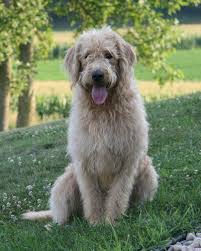The history of the breed
Labradoodle is undoubtedly a remarkable dog. His story began in Australia in 1988. One woman, whose eyesight deteriorated, began seeking an assistance dog. However, it was supposed to be a dog that did not cause allergic reactions of her husband. The reason why the woman chose Hawaii instead of Australia where he lived, was obvious. In Australia, there are very strict quarantine rules, much stricter than for Hawaii. So a dog traveling from Australia to Hawaii would not need to go through the quarantine.
 In response to the woman’s request, around thirty samples of poodle’s hair and saliva have been sent to the laboratory in Hawaii. Those samples were examined in order to check the contents of allergens. Unfortunately, none of them have successfully passed the test, which meant that none of these dogs would be appropriate for a woman’s husband, who was allergic.
In response to the woman’s request, around thirty samples of poodle’s hair and saliva have been sent to the laboratory in Hawaii. Those samples were examined in order to check the contents of allergens. Unfortunately, none of them have successfully passed the test, which meant that none of these dogs would be appropriate for a woman’s husband, who was allergic.
After some time, Wally Conron suggested the management of an Australian Association of Working Dog, to cross Labrador with Poodle. This is how the first litter was born. The litter consisted of three puppies and Wally called them “Labradoodle.” Again the samples of hair and saliva were sent to the laboratory. One of the puppies passed the tests successfully. The dog named Sultan went to Hawaii to spend the rest of his life alongside his mistress, as a working dog. From what I know – at the age of 10 he was still working as an assistance dog. After this success W. Conron crossed Labradoodle with Labradoodle and named its offspring “Double Doodles.” Then he crossed the “double Doodle” with “double Doodle,” and named their offspring “Tri Doodles.” These in turn were the precursors of today’s multi-generational Australian Labradoodles.
When Wally retired, Kate Schoeffel — vet from Australia who was with him in constant contact, started her program, in which she crossed Labradors and miniature Poodles.
A few years later, new breeders delighted with the look of the dogs started “massive production” not concentrating of what is the best the breed has to offer – hypo allergic potential as well as the service dog abilities. After some time, however, new breeders appeared. They had a vision and an organized plan. Those are the ones who devoted all their lives to create a Multi-generation Australian Labradoodle, which is recognized today. In 1989, in Australia, in Darnum, Victoria, Rutland Manor Breeding and Research Center was created. It is led today by Beverley Manners. Her dogs: Labradors, Poodles and Labradoodle of 3rd generation, were the only dogs, on which such strict health tests were carried out. At the same time in Seaspray, Victoria Tegan Park Breeding and Research Center was founded. It was owned by Angela Cunningham (daughter of Beverley). Tegan Park, also treated the matter of health testing with a great caution, using for reproduction only dogs that have passed tests to detect genetic diseases. Both founders — the Rutland Manor and Tegan Park, worked on their programs separately, however their goals were identical. They spent years of studies to further develop the breed and archival reports were analyzed constantly. In their programs they used a variety of combinations: returning to Labrador, poodle, Labradoodles crossed with Labradoodles, and the results of these associations were carefully analyzed every 12 months. Over the years of selections two founders managed to eliminate the shedding coat. As a result of these actions multigenerational Australian Labradoodles, rarely shed or do not shed at all.
Tegan Park retired in 2008. Beverley Manners of Rutland Manor continues her work today.
Years of conscious selection of the two centers have led to what we recognize today as a multigenerational Australian Labradoodle — Australian working dog. Not shedding, hypoallergenic with a great temperament. A dog that is perfect for the role of assistant or guide dog.
Some time ago Beverley told me a very touching story, of a girl suffering from epilepsy, who received a Labradoodle from Beverley. The girl called her dog “my Guardian Angel” — her guardian angel is intended to alert her of an unexpected attack of epilepsy. Ever since he appeared in their family, the parents are much calmer as they know they leave their daughter in “good paws”.
Staying in touch with one of the research centers which I visited and staid for a month — Rutland Manor, I am pleased to continue the program and create a history of an Australian Labradoodle in Poland. I believe that here, this marvelous breed will work miracles as well.